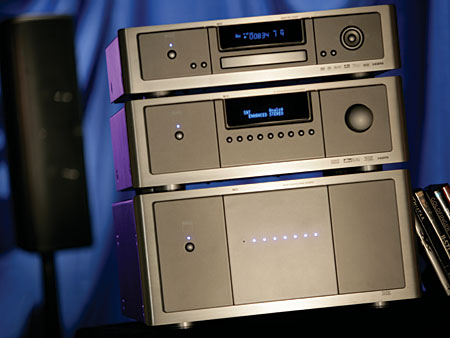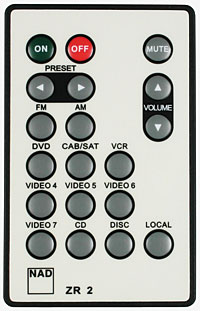NAD Masters Series M15 Pre/Pro, M25 Amplifier, and M55 Universal Disc Player
The component that put NAD on the map in the mid 1970s—the 3020 integrated stereo amplifier—didn't look like a giant killer. Finished in an indeterminate shade of grayish-brown and devoid of gee-whiz features, the 3020 nevertheless became one of the best-selling audiophile amplifiers of all time—and not just because it sounded better than anything going for two or three times its humble MSRP. The 3020 had that special something that made it, well, lovable. Over the decades, the engineers squeezed a bit of the 3020's magic into every NAD product, but they've pulled out all the stops with the new Masters Series components. They had to, as the ultimate NADs are competing with the likes of Anthem, Arcam, B&K, and Rotel. They're playing with the big boys now.

The Masters Series M15 pre/pro, M25 seven-channel power amp, and M55 DVD/SACD player's handsome good looks are a radical upgrade from NAD's usual plain-wrapper aesthetic. The new models' subtly sculpted steel-aluminum and zinc chassis inspires confidence, and their top panels' inset perforated metal grilles are a distinctive design motif. The beautifully finished components exude class.
 Masters and Commander
Masters and Commander
I immediately fell for the M15's clean ergonomic design; it's a lot less intimidating than a typical surround processor. Setup navigation was straightforward, and I liked that the M15 lets you hide unused inputs so only the remaining inputs are active. You won't waste time searching for your sound. The connectivity suite includes switching capabilities for two HDMI sources, say an HD cable box and maybe a Blu-ray player. This is great, but be aware that the HDMI switching is for video only—you still have to hook up digital audio cables. If you've opted for the matching Masters Series M55 universal player, you'll have to wrangle six analog cables, as well, to hear high-rez audio from DVD-Audio and SACD discs.
You can fine-tune the sound with the M15's bass and treble controls, and the Center Dialog control can tweak your center speaker's tonal balance to more closely match the front left and right speakers. Anyone considering a multiroom installation will appreciate the M15's AMX and Crestron compatibility, 12-volt triggers, and neat little second-zone remote control.
While the M15 offers adjustable lip-sync delay to match sound with tardy video displays, you can't store the delay setting in the M15's memory. Since most folks probably won't use the delay, that's not that big of a deal. If you do want to use it, you'll have to reset the delay every time you turn on the M15.
Plays All Kinds
The M55 player spins DVDs, CDs, DVD-Audio, and SACD discs. While the latter two formats haven't broken through to the mainstream in any significant way, new discs are still coming out. The soon-to-be-released Doors boxed set will sport DVD-Audio-encoded DualDiscs, a bunch of Moody Blues titles are now available on SACD, and audiophile labels like Telarc and Chesky Records continue to release new SACDs. This reminds me: The M55 is one of the few universal players that doesn't convert SACD's native Direct Stream Digital signals to conventional PCM digital. NAD's purist approach delivers the very best sound from SACDs. It's also worth noting that the player has separate bass-management paths for DVD-Audio and SACD playback to maintain the utmost quality. On the video side, the M55 offers Faroudja DCDi upconversion to 480p, 720p, and 1080i resolutions over HDMI and component outputs. All of the video outputs are always active, ready to send video to a second zone. One nitpick: The M15 mutes DVD sound for a couple of seconds when the M55 changes chapters.
 The M15 and M55's slick-looking remotes are fairly well laid out and comfortable, but only the M15's is backlit. The M15's provides direct access to the center, surround, and subwoofer volume levels, so it's easy to tweak the balances when you're changing discs. There is also a USB connector for possible future upgrades.
The M15 and M55's slick-looking remotes are fairly well laid out and comfortable, but only the M15's is backlit. The M15's provides direct access to the center, surround, and subwoofer volume levels, so it's easy to tweak the balances when you're changing discs. There is also a USB connector for possible future upgrades.
Quiet Power
The M25 is rated as a 160-watt (times seven channels) power amplifier, but it feels and sounds more powerful. I reckon NAD's PowerDrive circuitry is responsible for that, because it can nearly double the output power on a short-term dynamic basis.
The M25 amplifier's three large cooling fans are thermostatically controlled—they only run as fast as they need to. And here's the really cool part: The fans shut down during quiet passages, so you will never hear any fan noise from the M25. Plus, no matter how much I cranked the sound, the fans were always dead quiet.
 I had the M25 sitting on the floor next to my right speaker and found the amp's bright blue LEDs to be somewhat distracting during movie watching. I checked, and there isn't any way to turn off or dim the eight LEDs.
I had the M25 sitting on the floor next to my right speaker and found the amp's bright blue LEDs to be somewhat distracting during movie watching. I checked, and there isn't any way to turn off or dim the eight LEDs.
Soul Asylum
The Masters Series components produce a sound you can luxuriate in. They're so richly balanced, I wondered if they were maybe a little too mellow. I spent some time comparing the newly remastered and expanded edition of Aretha Franklin's Aretha Live at Fillmore West CD with the original CD. The NADs dramatically revealed the new version's heightened transparency, clarity, and dynamic life. I sat there swooning over the sweet soul music, totally captivated by Aretha's grooves. The Masters Series components were just letting the music come through, without adding any false emphasis. They're champs at sorting out the refinements that a superior mastering job can provide. Detail retrieval is top notch.
Guitarist John Abercrombie and bassist Eddie Gomez's jazz Structures SACD sounded even better. The tactile sense of Gomez's fingers moving over the strings on his stand-up bass was totally convincing, and the first time I heard him quietly humming and vocalizing with the music, I couldn't believe how real he sounded. Abercrombie's slow-motion guitar notes hung suspended in the air over the left speaker; the treble detail was beautifully balanced and effortless. The sound's three-dimensional presence was so clear that I could almost see the musicians. If more SACDs sounded like this, the format would stand a fighting chance.
Spike Lee's latest, Inside Man, doesn't stray too far from the well-worn bank-heist/hostage formula, but the DVD's sound was anything but routine. Terence Blanchard's pumped-up score perfectly supports the onscreen tension, and, when the inevitable gunfire erupted, the sound made me jump. Even when I had it cranked to a stupidly loud volume, the M25 amp never strained to keep up. And, as far as I could tell, the PowerDrive never shifted into overdrive. No matter how hard I pushed the Masters Series components, their sound had a remarkable sense of precision.
Best of all, NAD hasn't forgotten their roots. The Masters Series components are—by high-end standards, at least—solidly in the affordable range. They're the best-sounding components that I know of for the money, that's for sure.
Highlights
• The Masters Series has NAD's best-ever components
• Looks, feels, and sounds like more expensive gear




























































